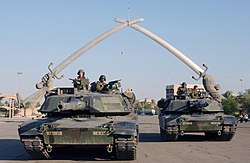Military occupation
Military or belligerent occupation is hostile control[1] by a ruling power over a sovereign territory that is not part of the ruling power's own sovereign territory.[2] The controlled territory is called occupied territory, and the ruling power is called the occupant.[3] During a military occupation, the occupier has certain responsibilities to uphold public order.[4]
Hundreds of years ago, the old notion of "to the victor belong the spoils"[5] was replaced with the new notion that sovereignty was not to be taken from a state by force. Military occupation, which is a loss of a sovereign's control of a territory, but not a loss of sovereignty, was thus considered temporary. Ideally, a peace treaty would soon return control to the ousted sovereign.[6]
Examples of military occupation
Military Occupation Media
American tanks at the Victory Arch in the city of Baghdad during the occupation of Iraq, 2003
Indian troops of the 5th Royal Gurkha Rifles in the city of Kure during the Allied occupation of Japan, 1946
German troops at the Champs-Élysées in the city of Paris during the Prussian occupation of France, 1871
Lebanese protesters of the Cedar Revolution during the Syrian occupation of Lebanon, 2005
German postage stamp inscribed with "Soviet Occupation Zone" in the city of Berlin, 1948
An Israeli soldier managing Palestinians at the Huwara checkpoint in the occupied West Bank, 2006
Related pages
References
- ↑ Benvenisti, Eyal (2012). The International Law of Occupation (Second ed.). Oxford University Press. p. 63. ISBN 978-0-19-958889-3.
Once control is established, occupation begins. This is captured by a partial award of the Eritrea-Ethiopia Claims Commission (2004) which stated that 'where combat is not occurring in an area controlled even for just a few days by the armed forces of a hostile Power, the Commission believes that the legal rules applicable to occupied territory should apply.
- ↑ Benv: "For all those reasons, the utility of retaining the adjectives 'belligerent' or 'wartime' or even 'military' has become rather limited, as the trigger for international regulation is not the mode of assuming control by the occupant but the temporary suspension of the sovereign's authority."
- ↑ Fabre, Cécile (14 February 2012). "Living with the enemy: the ethics of belligerent occupation" (PDF). Archived from the original (PDF) on 30 November 2018. Retrieved 30 November 2018.
- ↑ Benv: The authority of the legitimate power having in fact passed into the hands of the occupant, the latter shall take all the measures in his power to restore and ensure, as far as possible, public order and [civil life], while respecting, unless absolutely prevented, the laws in force in the country.
- ↑ Cole, Babalola (Summer 1974). "Property and the Law of Belligerent Occupation: A Reexamination". World Affairs. JSTOR. 137 (1): 66–85.
The law of belligerent occupation evolved slowly with an increasing and consistent movement toward justice and humanity. Prior to the last century, in the absence of any international code of conduct, the belligerent occupant dominated the occupied territory and its citizens. The principle or idea which guided the combatants—in this lawless setting—was 'to the victor belong the spoils.' At the same time, no real distinction was made among military occupation, conquest, and subjugation.
- ↑ Benv: "the delegates to the Brussels and Hague Conferences conceived occupation as a transient situation, for the short period between hostilities and the imminent peace treaty, which would translate wartime victories into territorial concessions by the defeated party."





